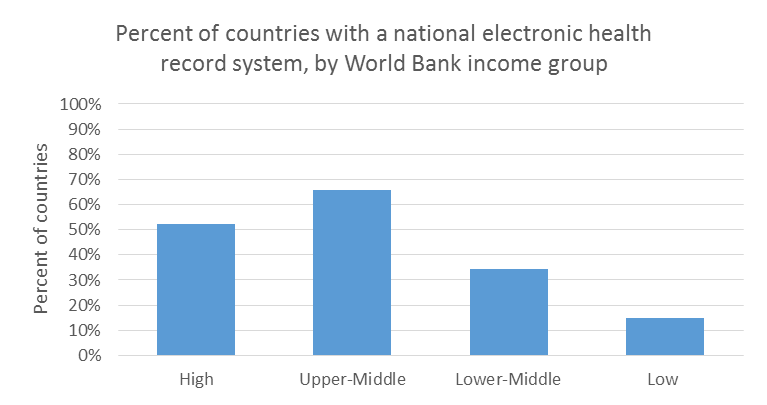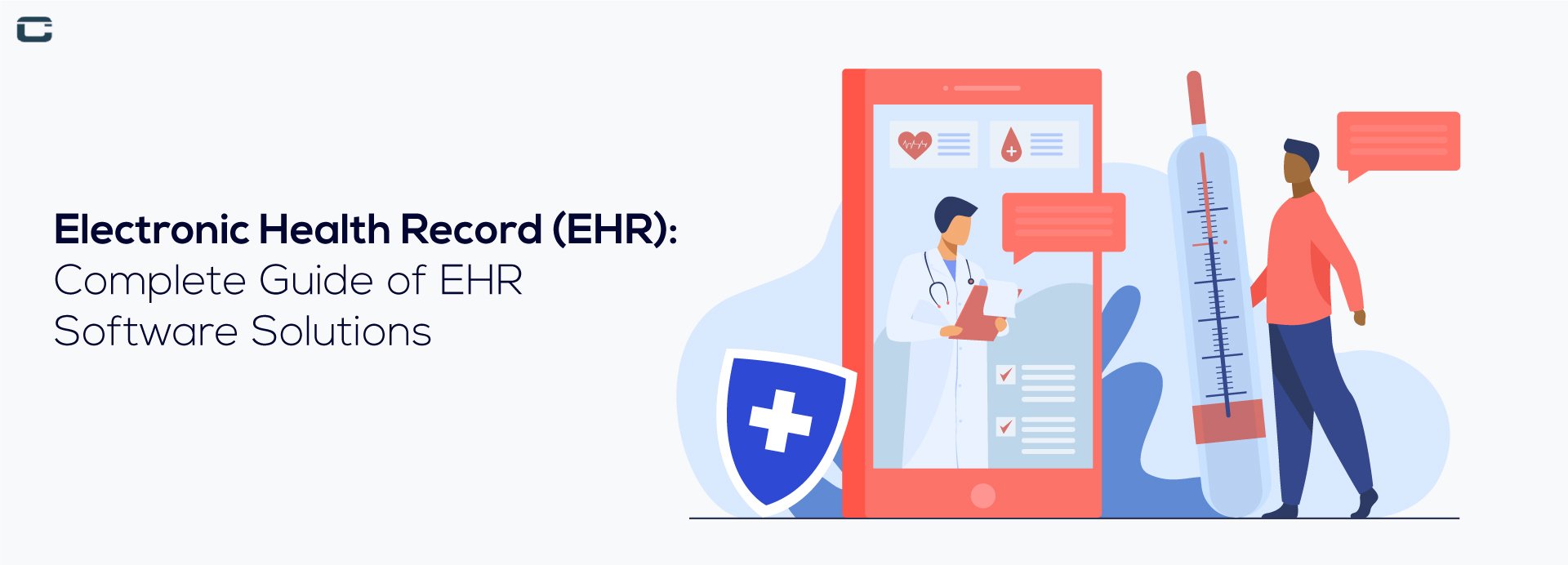An Electronic Health Record (EHR) is an individual's official health document that is shared among multiple facilities and agencies. The role of EHRs is becoming increasingly influential as more patient information becomes digital and larger numbers of consumers express a desire to have mobile access to their health records. An EHR automates access to information and has the potential to streamline the clinician’s workflow. The EHR also has the ability to support other care-related activities directly or indirectly through various interfaces, including evidence-based decision support, quality management, and outcomes reporting.
EHRs are the next step in the continued progress of healthcare that can strengthen the relationship between patients and clinicians. The data, and the timeliness and availability of it, will enable providers to make better decisions and provide better care.
World Health Organization(WHO) key findings from the reported data:
- There has been steady growth in the adoption of national electronic health record (EHR) systems over the past 15 years – and a 46% global increase in the past five years.
- >50% of upper-middle- and high-income countries (n=23) have adopted national EHR systems.
- Adoption rates are much lower in the lower-middle (35%; n=10) and low-income countries (15%; n=3)
- The majority of Member States with national EHR systems report integration of EHR systems with laboratory (77%; n=44) and pharmacy (72%; n=41) information systems, followed by picture archiving and communications systems (PACS) (56%; n=32).
- The most frequently cited barriers to the implementation of EHRs were lack of funding, infrastructure, capacity and legal frameworks.

(Source: WHO)
Among other types of data, an EHR typically includes:
- Contact information
- Information about visits to healthcare professionals
- Allergies
- Insurance information
- Family history
- Immunization status
- Information about any conditions or diseases
- A list of medications
- Records of hospitalization
- Information about any surgeries or procedures performed
Electronic Health Records (EHR) are designed to store data accurately and to keep a track on a patient's state across time. An EHR minimises the risk of data replication as there are no other modifiable files, meaning the file can be updated and reduces the risk of loss of paperwork.
Benefits of Electronic Health Records (EHR)
Better Quality of Care
Since EHR enables quick access to the records of the patients, it helps provide better care for the patients. EHR also helps in bettering the treatment while it increases the practice's operational efficiency. EHRs provide physicians with health analytics that help them recognize patterns, which helps predict diagnosis, and recommend potential treatment choices. This is how Electronic Health Records better quality of care:
- Easy and quick access to patient records
- Increases the treatment effectiveness
- Helps in suggesting potential treatment
- Makes the communication between the patient and physician better
- Helps in improving preventive care
More Accurate Patient Information
Electronic Health Records was originally introduced as an alternative to paper medical records. It’s developed for storing patient's information and for easy access. Electronic files have a lot of advantages over paper medical records. Like storing records on Electronic Health Records diminish the risk of data theft, misplacement of data, or damage to the data. Any mistakes or errors that can be caused due to handwriting are also diminished with Electronic Health Records. Patient's information can be updated in real time by the physicians, this leaves them with an accurate patient file.
Interoperability
Electronic Health Record's interface with other systems like Electronic Medical Records; this lets medical practices to advance continuity of care. An EHR system that provides physicians with interoperability is critical.
Increased Efficiency
Electronic Health Records not only help provide physicians with accurate patient records, but also saves time. EHR accelerates the appointments and office visits while keeping a patient centric approach at the same time. This results in physicians/health providers seeing more patients than before on a regular basis. Artificial Intelligence (AI) is making its way into Electronic Health Records platform. This would assist health providers with diagnosis and interpreting historical records of the patient.
Increase in Revenue
Every business owner sets a goal of maximizing its revenue. This holds true for healthcare organizations as well. Electronic Health Records offer billing and payment tools which manage income and make sure the payment is done. EHR allows doctors to document every visit done by a patient, which comes in handy while providing evidence about the claim.
Since the government provides monetary incentives to practices that implement Electronic Health Record systems, healthcare institutions can earn thousands of dollars just for implementing a certified solution. EHR software has been designed to help medical practices meet guidelines and prepare for upcoming mandates.
Must Have Features of an Electronic Health Records (EHR) System
Your quest to build an Electronic Health Records system starts with understanding the must have features of an EHR system.
Patient Portal
This is the most basic yet the most important feature of an Electronic Health Records system. You need to know how to create a patient portal in order to create an EHR system. It should include name, age, medical information, allergies, lab tests, medication, and everything else. Moreover, the Electronic Medical Record (EMR) system's patient portal is accessible to all concerned to all personnel. A patient’s portal on the EMR software allows the physicians to record, add, and view this data.
E-Prescriptions
Another essential feature for an Electronic Health Record System is E-Prescriptions. This is an exclusive portal that records and maintains all the prescriptions. An Electronic Health Record System consists of treatments, conditions, and history of the concerned patient's health. So, knowing how to create this feature is quite critical.
Charting and Documentation
An EHR software development process needs to have charting functionality. Electronic Health Record Software allows the doctors and physicians to fill out the charts and forms with efficiency. Allow the customization of chart templates, you can also add voice recognition features to ease out the process furthermore with the help of automation. Your EHR software must optimize as per the underlying device. Machine Learning can automate this process a little more; for this you would need an expert team of developers.
Integration with the Labs
In this step we have a lab integration feature, which again is a must have. Lab Integrations lets doctors/physicians track and get results. This helps them in understanding how to move forward with the treatment. This feature fastens the whole process and builds credibility. The labs would know what tests to conduct and the doctors would receive accurate results. For this, you will have to connect the patient's medical history with the current procedure. This will also make lab technicians aware of the conditions. With the help of such features, lab technicians can identify the reason for the patient's condition and communicate directly with the health provider.
Access Control
While learning how to build an EHR software, acquiescence is fundamental. Due to the fact we have some privacy rules, not everyone can have access to the patient's information and medical history. Only their health providers can have access to their sensitive information. To control access, you need to build your EHR software with certain preset restrictions. This means you will have to add rigorous access control features. It is quite crucial to secure the application.
Now you must think, how to develop such a software. Start with the Technology Stack applicable to the frameworks and architecture.
| Front End Development | |
|---|---|
| Libraries | Vue.js, React |
| Languages | CSS 3, JS, HTML 5 |
| Back End Development | |
| Server | NGiNX |
| App Frameworks | Laravel |
| Databases | My SQL, Redis |
| Hosting | AWS, VULTR |
How much number of development team need to develop and EHR software:
- One Front End Developer
- Two Back End Developers
- Two Quality Assurance
- One Project Manager
- One UI/UX Designer
The cost of an EHR system depends highly on the hours of work that has been put into developing it, moreover it could also depend on your location.
| Task | Hours Taken | Rate Per Hour | Cost |
|---|---|---|---|
| Business Analysis | 60 | $50 | $3000 |
| Design | 45 | $50 | $2250 |
| Backend Development | 142 | $50 | $7100 |
| Frontend Development | 155 | $50 | $7750 |
| Implementation of Roles | 33 | $50 | $1650 |
| Database Design | 30 | $50 | $1500 |
| HIPAA Compliance | 100 | $50 | $5000 |
| Quality Assurance | 140 | $50 | $7000 |
| Project Management | 95 | $50 | $4750 |
| Total Cost | 800 hours | - | $40,000 |
Wrapping Up
Electronic Health Recorders can play an important role in improving the healthcare sector; this would only happen once we are well acquainted with foundational data and analytics pieces in places.India is facing a radical rise in heart diseases, diabetes, and pulmonary diseases. It needs to build up its healthcare providers with EHR systems so that they are able to efficiently study the disease pattern and reduce the burden. Connect with the Cypherox expert developer to build your first EHR software system to manage all your patients data and say goodbye to hard paperwork.






